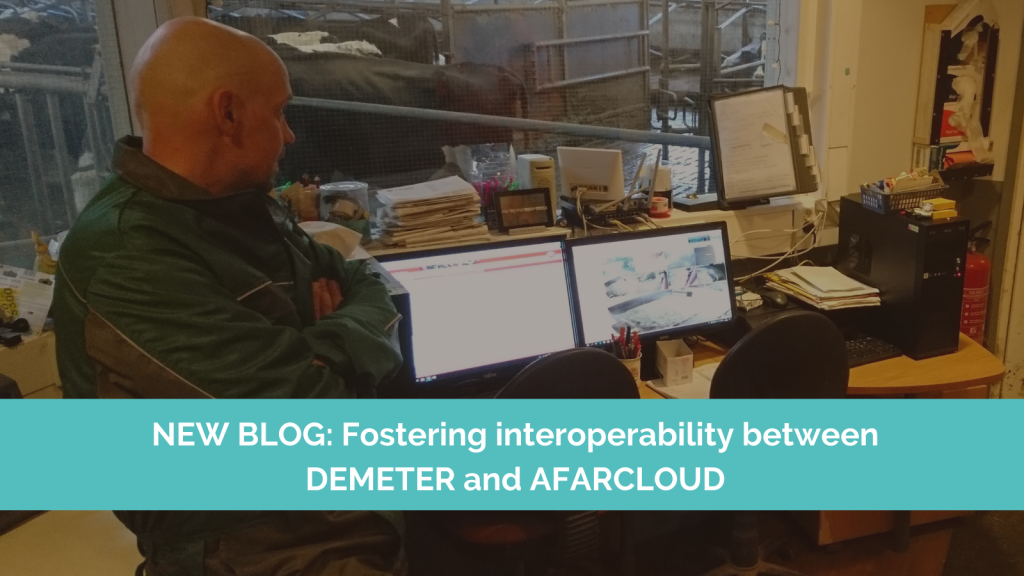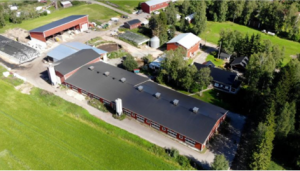
One of the goals of DEMETER is to be interoperable with other existing smart farming-IoT based solutions, so that both communities can exchange information and services for a mutually beneficial collaboration. In this blog we will analyse the interoperability between DEMETER and AFarCloud platforms, which is being demonstrated in use case no. 1 (UC#1) of DEMETER pilot 5.2 “Farm of Things in Extensive Cattle Holdings” where we seek to ensure the optimal feeding of cows by managing animal wellness and measuring crops and soil properties.
 The AFarCloud (Aggregate FARming in the CLOUD)[1] platform is the result of an ECSEL JU project that aims to provide a distributed platform for autonomous farming that allows the integration and cooperation of agriculture Cyber Physical Systems in real-time in order to increase efficiency, productivity, animal health, food quality and reduce agricultural labour costs. AFarCloud is aimed at early adopter farmers and rural professionals which require the management of crops and livestock information in real-time. The platform offers a GUI for farm management that supports monitoring and decision-making based on Big Data and real time data mining techniques. The main features offered by AFarCloud platform are the support for near real-time monitoring of crops and livestock; algorithms and definition of prescription maps for precision farming; and automation of agricultural tasks by the management of UAVs (Unmanned Aerial Vehicle) and UGVs (Unmanned Ground Vehicle). By combining these technologies, farmers can automate targeted key interventions, such as defining prescription maps that determine the exact amount and location to apply fertilizer or measuring the NDVI (Normalized Difference Vegetation Index) of crops.
The AFarCloud (Aggregate FARming in the CLOUD)[1] platform is the result of an ECSEL JU project that aims to provide a distributed platform for autonomous farming that allows the integration and cooperation of agriculture Cyber Physical Systems in real-time in order to increase efficiency, productivity, animal health, food quality and reduce agricultural labour costs. AFarCloud is aimed at early adopter farmers and rural professionals which require the management of crops and livestock information in real-time. The platform offers a GUI for farm management that supports monitoring and decision-making based on Big Data and real time data mining techniques. The main features offered by AFarCloud platform are the support for near real-time monitoring of crops and livestock; algorithms and definition of prescription maps for precision farming; and automation of agricultural tasks by the management of UAVs (Unmanned Aerial Vehicle) and UGVs (Unmanned Ground Vehicle). By combining these technologies, farmers can automate targeted key interventions, such as defining prescription maps that determine the exact amount and location to apply fertilizer or measuring the NDVI (Normalized Difference Vegetation Index) of crops.
 The interoperability between DEMETER and AFarCloud is being tested in the Kotipelto farm[2], a dairy farm located in Ylivieska (Finland). This farm aims at ensuring animal welfare by managing their nutrition. In this sense, it is important to predict the exact harvesting time to achieve the maximum nutritional value of grass.
The interoperability between DEMETER and AFarCloud is being tested in the Kotipelto farm[2], a dairy farm located in Ylivieska (Finland). This farm aims at ensuring animal welfare by managing their nutrition. In this sense, it is important to predict the exact harvesting time to achieve the maximum nutritional value of grass.
To integrate the data gathered by AFarCloud-compatible sensors into DEMETER, two enablers have been made available:
- A data transformation enabler[3], which provides semantic interoperability between the AFarCloud and DEMETER AIM information models, by transforming AFarCloud compatible JSON data with sensor observations into JSON-LD data compliant with the DEMETER AIM (Agricultural Information Model);
- A data preparation and integration enabler[4], which integrates AFarCloud sensors and IoT devices into the DEMETER ecosystem. This enabler is connected to the AFarCloud platform to ingest the data in real-time, transform it to the DEMETER AIM, and finally store it in a semantic repository.
 By making both ecosystems (DEMETER and AFarCloud) interoperable, the two communities can mutually benefit in a variety of ways. Thanks to DEMETER, the AFarCloud community can have access to and take advantage of a greater variety of targeted data analytics tools and decision-making services. Moreover, some of the DEMETER’s DSS services address targets of interest to AFarCloud, such as plant yield or soil moisture estimation, variable rate of fertilization, or animal welfare condition estimation. Farmers can visualize this information in an intuitive manner, thanks to the visualization tools developed in DEMETER, that present the information in a way that is easy to understand by the end-user.
By making both ecosystems (DEMETER and AFarCloud) interoperable, the two communities can mutually benefit in a variety of ways. Thanks to DEMETER, the AFarCloud community can have access to and take advantage of a greater variety of targeted data analytics tools and decision-making services. Moreover, some of the DEMETER’s DSS services address targets of interest to AFarCloud, such as plant yield or soil moisture estimation, variable rate of fertilization, or animal welfare condition estimation. Farmers can visualize this information in an intuitive manner, thanks to the visualization tools developed in DEMETER, that present the information in a way that is easy to understand by the end-user.
On the other hand, DEMETER can also benefit from being interoperable with AFarCloud. The AFarCloud platform uses semantic models that, in the same way as the DEMETER AIM, abstract the heterogeneity of the underlying resources, and ensure that all information is stored according to a common information model that guaranties interoperability. AFarCloud contributes to the Demeter AIM in several aspects. Both the DEMETER AIM and the AFarCloud information model are based on the SSN (Semantic Sensor Network)[5] and SOSA (Sensor, Observation, Sample and Actuator)[6] ontologies for modelling sensors, actuators, devices and observations like soil data and other sensor measurements. However, AFarCloud extends the model by defining a taxonomy of the most common sensor and observation types used in agriculture. Besides, AFarCloud also provides a model for representing mission planning with robotic vehicles. Examples of missions that are of interest for agriculture are: supervision of areas using collaborative UAVs, gathering observations from sensors using a UAV or UGV, generation of NDVI maps from images taken by UAVs, sending prescription maps to tractors, etc. Finally, AFarCloud also provides a model for animals and dairy farms that could be useful for some pilots in DEMETER.
[2] http://www.kotipelto.fi/en/
[3] https://hub.docker.com/r/sbilbao/dem-afc-aim-enabler
[4] https://hub.docker.com/r/sbilbao/afc-dem-integration-enabler


